Archive for ‘Psychological’ Category
Spooky Clutter: Fears that Keep You from Getting Organized
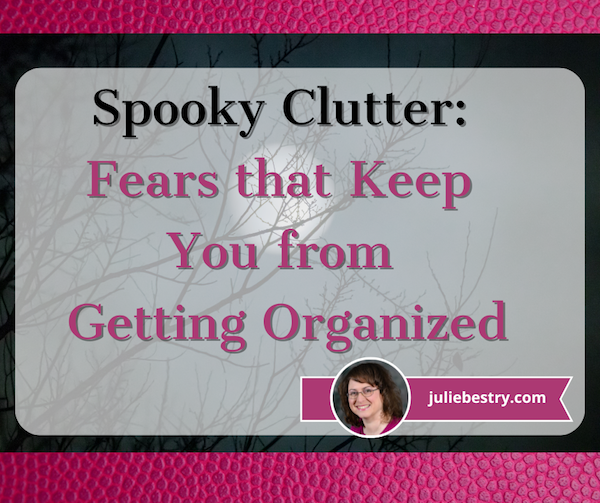
Portions of this post originally appeared in 2015.
PAPER DOLL FEARS FEAR
This week is Halloween, a time for ghosts, goblins, vampires, and other scary creatures. I’ve never been a fan of the fearful aspects of Halloween, opting for silly costumes rather than frightening ones. (More than once, I’ve sewn spare socks and washcloths to a sweatshirt and gone as static cling. Shocking!)
I’ve never understood the appeal of being being frightened in a visceral way: horror films, scary pranks, roller coasters. I’ve never adored the original Bela Lugosi, Eastern European-accented vampires, nor the “hot and sparkly” modern-day Twilight vampires; give me Buffy the Vampire Slayer‘s snarky Spike over brooding Angel any day.
That said, nobody can dislike Count von Count from Sesame Street, especially a professional organizer, as numbers offer us so much help in organizing things by date or priority!
(This is about as scary as Paper Doll can handle things.) The point (and I do have one) is that I’ll pass on thrillers, espionage, and creepy demons, whether they’re climbing out of graves or television sets.
The only “fear” I enjoy is when a character fears that all is lost and there is no hope to be united with one’s great love, only to be shocked by a proposal! Jane Austen has my back. Well, the ghost of Jane Austen, anyway. That said, I still don’t know what to say about Pride and Prejudice and Zombies, which I find so uncomfortably scary and gruesome that I can’t bring myself to post the actual video of the trailer!
FEAR HAS BENEFITS
Before I get into how fear intersects with organization, I should point out that fear obviously has some merits. While I’m not entertained by heightened fears and the relief of it brought on by experiences like horror movies and haunted houses, I understand the appeal of the rush of endorphins.
Beyond entertainment, fear can act as a powerful protective catalyst in multiple ways:
- Promoting Caution and Safety — When we have fear of a negative result, it can encourage us to exercise caution in order to avoid harm or negative consequences. If we’re afraid of embarrassing ourselves by doing a poor job in a work presentation, we will do more research, seek feedback, and rehearse. If we fear being carjacked or mugged, may make better decisions when we go out and avoid potentially dangerous situations.
Of course, if we take fear to the extremes, it keeps us from taking any kind of actions that could improve our situation. Fear of failure can keep us from accepting a promotion or trying a new hobby, and being overly cautious may prevent us from reaping benefits of new situations.
*Inaction breeds doubt and fear. Action breeds confidence and courage. If you want to conquer fear, do not sit home and think about it. Go out and get busy.* ~Dale Carnegie Share on X- Inspiring Preparedness and Planning — We professional organizers love preparing for any eventuality. For example, see last month’s Paper Doll Organizes You to Prepare for an Emergency.
At its best, fear can help us spot potential challenges or adverse circumstances, and motivate us to be proactive, developing and embracing strategies that will mitigate risks, protect us from negative consequences, and develop contingency plans.
If you’re afraid of technology and fear your computer crashing, you can take in the advice of a post I wrote for Write*Publish*Sell entitled 9 Ways to Keep Your Writing Safe. If you’re afraid of situations that where the key person at home won’t be there, check out Cross-Training for Families: Organize for All Eventualities. And for a deeper look at the concept of backing up, October’s Productivity & Organizing Blog Carnival is all about The Back-up Plan!
On the downside, when taken to extremes, an excess of caution and preparedness can prompt people to hold onto everything “just in case,” never considering how that sentence ends. Just in case — of what? Too often, people’s fear’s lead to inertia, never recognizing how dangerous inertia can be.
- Enhancing Alertness and Awareness — Fear triggers the body’s fight, flight, or freeze response. The body releases adrenaline so that we can act quickly and respond to imminent threats.
At the positive end of the spectrum, fear can heighten our senses. Whether it’s hair standing up on the back of our neck when we enter a dark house or we sense someone’s presence just before we actually see a stranger, fear can help us be more vigilant so we can respond to potential dangers. We can hit that mugger with our umbrella or scream while running down the street.
Conversely, if we believe we cannot escape a scary situation, we tend to freeze. (This is true in active situations, where we fear the oncoming danger, or in passive situations, where we fear what will happen if we let go of possessions we may need in the future.)
- Enforcing Boundaries — Fear has the potential to encourage us to set personal boundaries, establish limits, and enforce them. When the issue is a creepy dude or an overbearing relative, a (mentally and physically) healthy reaction to fear prompts us to set boundaries for how we allow others to treat us.
Someone who has experienced trauma (like a house fire or financial devastation) may feel unable to ever let possessions go because the excess clutter serves as a buffer against that sense of loss. However, facing fear and setting boundaries regarding what is useful and pleasing vs. what is unnecessary can yield a greater sense of empowerment.
- Increased Resilience and Growth — Situations that trigger fear can challenge us to confront limitations and overcome obstacles. If we’re afraid of poverty, fear can trigger us to get more education and to be bolder in our job searches.
Realistically facing fears can serve as a catalyst for growth. If someone both anticipates negative emotions related to letting go of clutter and fears being stuck in a house that’s too big and difficult to care for, they may be inspired to call a professional organizer to get help downsizing.
Fear gives us the opportunity grow, develop inner resources, explore coping mechanisms, and deal with uncertainty.
As a professional organizer and productivity coach, I tend to deal with fears related to action-blocking emotions. However, if you’d like the explore the power of fear for more physical protection, one of the most highly recommended references is Gavin De Becker’s The Gift of Fear: Surviving Signals that Protect Us From Violence. It was originally published in 1977, and re-issued in 2021.
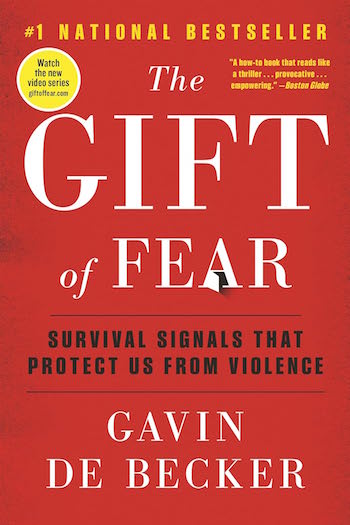
HOW FEAR KEEPS US FROM GETTING ORGANIZED
Fear keeps us from moving forward in our lives. It keeps us from going after exciting opportunities and leaving bad situations. In my line of work, every day, I see the ways in which the prospect of getting organized is both prompted by fear and avoided due to fear.
Staying disorganized can be scary.
When we are disorganized, we spend excess money on items because we either don’t know what we own or we can’t find what we own. We lose time redoing work, whether it’s the file that’s disappeared or the laundry with wrinkles set in because wet clothing never made it from the washer or the dryer.
Being disorganized can risk physical safety, whether that means parents stepping on pieces of LEGO left on the floor or a grandparent falling and breaking a hip because the house has become too full of excess to allow it to be properly put away.
And, of course, too much of too much causes anxiety. Taken to excess, embarrassment over the overwhelm of clutter keeps people from entertaining or maintaining close social ties, and the health risks of social isolation and loneliness have been found to include heart disease, stroke, diabetes, depression, anxiety, addiction, self-harm, dementia and shortened life-span.

Getting organized can be scary.
Let that idea sink in. It was definitely a surprise to me 21+ years ago when I started my business. I expected people would be excited by the prospect of decluttering and creating new systems, but also anticipated some might have avoided the process because they thought it would be boring or hard work. When I was a novice, I had no idea how powerfully fear was enmeshed with the prospect of getting organized.
Usually, we talk about getting organized from the perspective of practical matters. What’s the most efficient technique? What’s products can streamline the process? That’s what I was expected.
When we do talk about the psychology of getting organized, we’re often focusing on tips and tricks to get us motivated, to eliminate procrastination, or to keep us focused on a system, but we don’t necessarily dig into the idea that there are baseline fears, often unacknowledged, that prevent us from taking the steps we know will improve our lives.
Several year ago, I sat down with John Hunt, host of Smead’s Keeping You Organized video podcast, to record a show called “Fears That Keep You From Getting Organized.” I encourage you to watch and listen (with the understanding that it was recorded before the world — and Paper Doll — had embraced Zoom, videoconferencing, and decent lighting techniques)!
On the episode, we talked about some of the fears — unspoken or even unrecognized — that cause us to back away from our organizing challenges without really considering the solutions available. Some of these include:
- Fear of discarding something — Whether tangible or informational, you may worry that you might need it someday.
We call this the “just in case” fear. A popular piece of advice warrants letting go of something you don’t use if you can replace it for under $20 or in under 20 minutes of asking around.
Remember that “someday” is not a date on the calendar, and the quickest way to vaporizing your fear is to think concretely about the circumstances in which you might need “the thing,” consider how often (if ever) you’ve needed it in the past, and how you might approximate it’s use.
- Fear of stifling your creativity — Honestly, it’s impossible to use your creativity to the fullest if you can’t find the tools and resources of your creativity amid mountains and piles of clutter.
- Fear of potential emotional distress after discarding something — The Pareto Principle, also called the 80/20 Rule, reminds us that 80% of our success comes from 20% of our efforts; 80% of the time, we’re wearing 20% of our clothes or using 20% of our apps or gadgets. We professional organizers see every day that letting go of what people never, or hardly ever, use really leads to a greater sense of freedom.
- Fear of losing personal or sentimental attachments to people and memories.
It’s important to determine whether something actually has sentimental attachment for us or we just expect that because it’s old, or was a gift, or belonged to someone we loved, that we should have an attachment to it. Very often that’s not the case; when it is, by letting go of the things without true emotional attachment, the things we do keep are more meaningful and resonant.
- Fear of letting go of things upon which you’ve lavished money, time, or attention — otherwise known as the “sunk cost” fallacy.
I see clients who’ve held onto ancient computers from the 1980s because they cost so much, even though they can still only run DOS and not even the oldest (and entirely unsupported) versions of Windows. Other clients have held on to dresses or suits that they haven’t worn in decades and which no longer fit their bodies or their lifestyles.
It’s similar to staying in a relationship where you’ve put in all the effort and you never get anything back. Letting go of what no longer rewards you grants you the opportunity to spend your resources on things, experiences, and relationships that have the potential to make your life more meaningful.
Letting go of what no longer rewards you grants you the opportunity to spend your resources on things, experiences, and relationships that have the potential to make your life more meaningful. Share on X- Fear of the unknown. — The world can be scary, and not knowing what’s coming next can paralyze us with fear.
None of us can predict the future. A few months before COVID-19, I tossed out a few respirator masks, the kinds used for protecting your lungs when you paint. I could have kicked myself for not having masks when the pandemic hit, but instead of giving myself a hard time about not sufficiently fearing the future to ensure I was protected against ALL eventualities, I gave myself permission to face the future as it comes rather than being stuck in a quagmire of holding onto everything because it might somehow have value someday.
Of course, there are other fears that prevent us from achieving our organizing and productivity goals that we didn’t even get to, including:
- Fear of failure — “What if I spend time trying to create order and it turns out I can’t do it? Or I can’t maintain it?”
Instead of focusing on what might go wrong, we can concentrate on what skills and systems we an implement to lessen the possibility of things going awry and institute personal policies for catching things before they go too far off the rails.
- Fear of success — “If I declutter and get more organized, people are going to expect more from me and heap more work and responsibilities on my shoulders.”
This is a reasonable fear. The better we are at doing something, the more we leave ourselves open to being taken advantage of (intentionally or unintentionally). But the better we are at doing something, the more energy we will have to set and enforce our boundaries!
- Fear of loss of serendipity — “Right now, I’m delighted and surprised when I spend hours searching for something I can’t find, but come across something under a pile that I was looking for last week, or six months ago.”
Serendipity can be even better explored when we can access things we need. If we don’t waste our time, money, energy, and resources on re-done work, dual purchases, and scrambling to find lost items, we can turn our attention to our hobbies and interests and find serendipity in what we come across in the world of ideas, things, and people that reside outside our own no-longer-cluttered homes.
There are all kinds of fears. I believe that when we acknowledge our fears, we’re taking the first step toward recognizing that we have control over whether to give in to the inertia of fear or break through and empower ourselves for change.
May the only scary things in your future be tiny toddlers in more-adorable-than-terrifying costumes.
Take a Break for Productivity — The International Perspective

RECAPPING THE IMPORTANCE OF TAKING A BREAK
Last week, in Take a Break — How Breaks Improve Health and Productivity, we looked at the key benefits of taking breaks in helping us improve our mental and physical well-being as well as achieve our goals. These included:
- Enhanced physical health
- Reduced stress
- Increased energy and motivation
- Improved focus, memory, and concentration
- Prevention of decision fatigue
- Enhanced creativity and problem-solving
We also examined the various durations of breaks and their relative advantages for different purposes, from the teeny 20–20–20 breaks to prevent eyestrain (every 20 minutes of screen time, look away from the screen and focus on something at least 20 feet away for at least 20 seconds) to the quick breaks as we transition between meetings or tasks.
We looked extensively at the medium-length work breaks we often fail to indulge in (but need so much to refresh our bodies, brains, and spirits). Breaks benefiting the body include time taken for meals and snacks, resting and napping, walking, and even dancing, while pauses that improve mental function and emotional well-being include meditation or mindfulness, time spent in nature, and breaks for doing creative things, appreciating some aspect of life or culture, and socializing.
And, of course, breaks extend all the way to full vacations.
A SIDEBAR (SIDE TRIP?) FOR VACATIONS
Did you know that the longer a vacation is, the better it is for you, but only up to a certain duration? The average American worker is entitled to about 16 days of paid leave (combining holiday and vacation days), though we should note that about a quarter of workers get no paid leave at all!
Americans have a habit of trying glom vacation days onto long holiday weekends to try to pack month’s worth of need rest and relaxation into four days. While any break break is better than none, such short vacations fail to provide substantive recuperative benefits. Worse, according to a Pew Research Center Survey, 46% of U.S. workers who do get paid time off take less than they are allowed.
The reasons for workers shorting themselves time off vary and overlap: 52% don’t recognize the need, 49% worry that they will fall behind (and reap negative repercussions, including angering supervisors, risking their prospects for advancement (or even risking their jobs), and 43% feel guilty about their workload having to be handled by co-workers taking on additional work.
With all of these reasons not to take vacation, the counter-argument is obvious in the Harvard Business Review piece, You’re Never Going to Be “Caught Up” At work. Stop Feeling Guilty About It. Work keeps coming!
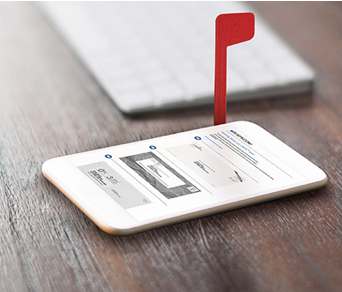 © United States Postal Service
© United States Postal Service
I always tell my clients that not only is Inbox: Zero largely a fallacy, so is Laundry Basket: Zero. Unless you decide to stop sending email or your family members all become nudists, it all keeps coming. We’re humans, not robots, and can do only so much. So, as the article says, we must practice self-compassion, focus on our accomplishments rather than our shortfalls, and use mindfulness.
Don’t guilt yourself into trying to accomplish an inhumane amount of work, and go back to last week’s post to see why you need to take breaks!
Finally, the Pew study didn’t take into account self-employed workers. We have our own reasons for not taking vacations; primarily, if we’re not working, we’re not earning, and without the predictability of a paycheck (and with the fear of clients forgetting we exist if we aren’t there to answer the phone), we’re hesitant.
But we all need vacation breaks for the same reasons we need those multiple daily breaks — to keep us physically and emotionally healthy, mentally sharp, and productive.
So how long should a vacation be?
According to a study published in the Journal of Happiness Studies, the ideal length of a vacation is approximately eight days. Researchers found that happiness levels rise over the first few days of vacation (as individuals acclimate to fewer stressful demands and the greater opportunity to sleep in those cushy hotel beds that they don’t have to make up themselves).
As physical and mental distance between work and vacation life expands, happiness peaks on the eighth day.
However, eventually the sense of well-being that comes from vacation starts to taper off, and by day eleven significantly drops. In order to get the most recuperative benefits of a vacation, researchers encourage taking multiple vacations spaced throughout the work year, ideally lasting between seven and 11 days.
A less academically stringent poll of 1000 respondents by Insider.com found that workers who took an average of 13 days off each year were satisfied and felt they took the “right amount” of time off, while those who wished they had taken more time off took an average of 10 days off. And, interestingly, people who said they took too much used an average of 14 days. (I suspect that’s where guilt starts to set in.)
Obviously, what you do with your vacation matters; you’re far more likely to be bored on day 12 of a staycation in snowy Detroit in January than on the same day of a two-week trip to Italy. Ask me how I know!

Day 12 in Venice, September 2018
Multiple 7-to-11-day vacations throughout the year? What did I say about a quarter of Americans not getting any paid leave at all? We might want to consider the health and productivity benefits of vacation trends around the world.
First, the European Union guarantees four paid weeks off annually. Beyond that:
- France — French labor law mandates a minimum of 30 working days of paid leave for employees.
- Finland — Finnish labor law also stipulates a minimum of 30 working days of paid vacation per year for employees.
- Austria — Austrian labor law guarantees a minimum of 25 working days of paid annual leave.
- Denmark — Danish labor law provides for a minimum of 25 working days of paid vacation.
- Germany — German labor law ensures a minimum of 24 working days of paid leave, which can increase based on the collective bargaining agreements and the length of service for an employee.
- Spain — Spanish labor law provides for a minimum of 22 working days of paid leave, with additional days for particular circumstances such as marriage, relocation, or special personal events.
It’s not just Europe. Brazilian labor law guarantees a minimum of 30 consecutive days of paid annual leave for workers, which can be split into three periods, one of which must be no less than 14 consecutive days! Panamanians get 30 days of paid vacation each year, on top of 10 paid holidays, while workers in India get 18 vacation days a year along with an additional 7 days of “casual leave,” totaling 25 paid (non-holiday) days each year.
But yes, Europeans in particular know how to take recuperative breaks. But what about those medium-length breaks we discussed last week, time taken out of our daily work grind, perhaps mid-morning, mid-day, or during the afternoon?
INTERNATIONAL TAKES ON BREAKS
Let’s look abroad to see what practices and rituals we might borrow, emulate, or at least appreciate from our international friends to successfully take pauses that refresh us.
Obviously acceptance (and formalization) of these practices vary by workplace and cultural context. Nonetheless, the significance lies in how these practices can promote work-life balance, foster true social connections, and/or enhance overall well-being and productivity.
BREAKS FOR REST
Siesta
Most of us are well-acquainted with the Spanish and Latin American tradition of siestas or afternoon naps, even if we’ve only learned of it from old movies or novels. A siesta is generally practiced as a nap (or at least rest) break after the mid-day meal, generally lunch.
Historically, the ritual of a siesta was practiced by rural workers to combat the effects of heat and bright sun in warm-climate regions. As the world became increasingly urbanized in the 20th century, the tradition of the siesta began to decline, to mixed results. While many workplaces have eliminated the option of time for a siesta, others have preserved the concept of a two-hour lunch break as a cultural tradition.
Indeed, those who have embraced the extended lunch (whether workers use it for sleep or just mental recovery) find that not only do employees benefit from being able to recharge and improve their work-life balance, but that workplace productivity increases for the latter part of the workday.
The value of a siesta has seen bit of a resurgence. In 2015, the mayor of the municipality of Ador, Valencia in Spain proclaimed a state-sanctioned right to an afternoon nap between 2 p.m. and 5 p.m. The edict was, in part, a way to guarantee that employers recognize that manual laborers and agricultural works could take breaks when high temperatures peaked. But the proclamation also encouraged residents to return home to nap, and requested that parents keep their children indoors and that workers refrain from making undue noise.

In 2017, Madrid saw the opening of Spain’s first nap bar in Azca, the Spanish capital’s financial district. Because most city workers can’t get home during the post-lunch afternoon slump, the nap bar provides private rooms (for about 14 Euro (~$14.81/hour) as well as shared rooms with bunk beds 10 Euros (~$10.58)/hour.
They also offer study nooks and cozy chairs, and if you want a shorter nap/rest time, you can book by the minute, and service includes a wake-up call!) (Germaphobes, worry not. Sheets are changed and professionally cleaned between uses.)
In the years since it opened, Siesta & Go has continued to expand and is now considered a hostel.
Mesimeri
In Greece, Cyprus, and many Mediterranean and Middle Eastern nations, Mesimeri refers to the midday break where businesses and offices often close for a few hours during the hottest part of the day. Mesimeri refers to the time between 2 p.m. and 5 p.m. where individuals have the opportunity to rest, relax, and enjoy a leisurely meal before resuming work later in the day.
The notion isn’t just taking a break, but that everyone is strongly encouraged to be quiet — road work and construction shuts down, and stores close. While the napping aspect of Mesimeri was practiced by almost all individuals until about 30 years ago, Greek laws still define official quiet hours where loud music and work-related noise outside are banned. It’s easy to see how these communal pauses, when everyone is allowed — even expected — to take breaks eliminates any sense of guilt about not powering through at work.
Inemuri
Culturally, it would be hard to find a productivity paradigm more at odds with Spain’s siestas, Mediterranean Mesimeri, or even France’s traditionally long lunches than Japan’s work-centric approach. In Japan, there are no formal, unified times for culturally agreed-upon rest breaks. Instead, there’s Inemuri.
Inemuri translates to “being present while sleeping,” and refers to a sort of cultural acceptance of napping in public, whether in the workplace, on public transportation, or in parks. Rather than “if you see something, say something,” in the U.S., where you might assume a dozing person is unwell, Inemuri suggests that if you see someone conked out, they are less likely to be ill or have been imbibing and more likely to be evincing signs of dedication to their employers and hard work.
Obviously, this work-til-you-drop lifestyle is not something we want to emulate, but the acceptance of Inemuri allows people to take short rest breaks throughout the day. So, at least there’s a culturally accepted practice giving workers the capacity to recharge during Japan’s excessively long work hours.
And, if you don’t feel like sleeping at your desk, there are nap cafés and even vertical nap pods available in many workplaces and cafés to grant privacy (so nobody sees you drool). For example, there’s the GiraffeNap, a TARDIS-like capsule with headrest, cushioned seat, and footrest.
If you’ve got more time to watch a TikTok influencer experience the full Janapese nap pod experience, try this:
Wu Wei
In China, the Taosist concept of Wu Wei can be translated as “non-doing” or “effortless action.” , and it emphasizes the essentiality of taking breaks in order to allowing yourself to be in harmony with the natural flow of life. Wu Wei is less of a specific break ritual, and more a way of thinking, living, and working such that society (and the work place) values time for rest and creating balance in daily activities.
For more about the power of napping and resting:
- Inemuri & Siesta — Method Behind the Madness
- Napping: Benefits and Tips
- The long-term memory benefits of a daytime nap compared with cramming
- The Pros and Cons of the Siesta
BREAKS TO EAT AND SOCIALIZE
Merienda
In Spain, Portugal, North Africa, Brazil, and The Philippines, Merienda is the practice of taking a mid-afternoon break from work or school for a light meal or snack. As you might expect, this practice is a more official opportunity granted for individuals to take a brief pause, enjoy some refreshments, and recharge before continuing with their tasks.
After all, as we discussed last week, when our blood glucose suffers, brain fog zaps our ability to learn, remember, focus, or create. A merienda meal generally consists of simple snacks (bread, fruit, yogurt) and beverages (from child-friendly milk, hot chocolate, and fruit juice to more adult-appealing coffee and even light alcoholic drinks).
In South America, particularly Uruguay, Paraguay, Argentina, and Brazil, the break is later in the day and a bit heavier, while in the Philippines, merienda culture the break for relaxation and rejuvenation comes twice a day, once in the mid-morning and again in mid-afternoon.
As long as you’re taking a break to read this post, want to make some merienda delicacies or read more about Spanish Meal Times and La Merienda — What and When to Eat?

La Merienda, or The Afternoon Meal, 1772, by Luis Meléndez, Metropolitan Museum of Art
Tea or Chai Break
Throughout the United Kingdom, places colonized by the UK over centuries, and in Asia, tea breaks for snacks (and not just the beverage tea) and socializing have been popular for the past two hundred years. The break for “a cuppa” is not merely culturally accepted, but respected, and provides the opportunity for workers and students to relax and foster social connections with their cohorts, both (as we discussed last week), improving well-being and productivity.
The equivalent of the tea break in India is the chai break, and similarly involves pausing work to enjoy a hot beverage, a snack, and some convivial conversation.
Riposo
Italy has lots of daily social rituals. La Passeggiata is a leisurely evening stroll designed to shake loose the cobwebs and stressors of the day and ease into the evening; it also gives people the chance to greet their neighbors.
Riposo is a bit of a cross between a siesta and a merienda. Many Italians practice a long riposo lunch break, closing during (varying hours) from Noon to 4 p.m. to go home (or to restaurants) and take an extended pause for lunch and quiet time. While this is less often observed these days by knowledge workers in offices, the riposo custom is still observed by stores, museums, and churches, while restaurants stay open throughout the afternoon to accommodate those not able to return home.
THE SWEDES TAKE THE CAKE FOR TAKING A BREAK
At the risk of sounding like a spokesperson for IKEA or the Swedish Tourism Board, Sweden has cornered the market on taking breaks for the betterment of everyone. They practice two break-reated concepts that are central to feelings of well-being and improved productivity.
Lillördag
Let’s start with the Nordic concept of Lillördag (pronounced lee-lur-dog), a Swedish word meaning “little Saturday.” Conceptually, it encourages breaking up the monotony of the workweek with the spirit of some weekend mojo.
Generally, Swedes practice lillördag on Wednesdays, and it often includes going out for drinks with colleagues. (When I worked in television, I found that this habit (particularly among the sales staff) was called “any day ending in a Y.” But I digress.)
Rather than being seen as a work-related obligation that might contribute to toxic productivity, lillördag generates the sense of a mini-vacaton mid-week, giving workers something to look forward to amid the drudgery of a typical workweek.
The goal is to actually combat toxic productivity, prevent burnout, and promote mental recovery. Participants are sociable, but they aren’t merely moving work-related conversations about client obligations or how annoying Carol in Accounting can be into a more convivial (or boozy) atmosphere. Rather, lillördagers (I made that up) are encouraged to avoid talking about cranky-making things and just be social.
When I first heard about lillördag, it reminded me of Laura Vanderkam’s advice in her book Tranquility by Tuesday: 9 Ways to Calm the Chaos and Make Time for What Matters about scheduling little weekly adventures!
Vanderkam found that to get out of our daily/weekly ruts, we all require more novelty, texture, and richness in our time and our tasks. Vanderkam encouraged everyone to plan life in weeks, and to identify one “big adventure” (lasting perhaps half a weekend day) and one “little adventure” (lasting an hour) each week to introduce novelty. As Vanderkam says, “We don’t ask where did the time go when we remember where the time went.”
With lillördag, the “little Saturday” break from workweek drudgery on Wednesday can enliven your spirit. But lillördag is truly little in importance when compared with Sweden’s biggest break concept: fika!
Fika
Considering that fika — a quasi mandatory (but relaxing) coffee and cake break — is so ingrained in, and important to, Swedish culture that it’s protected by law, it’s shocking that it’s not better known around the world.
The purpose of fika is not merely taking a snack break. It’s about slowing down, stepping away from work, and connecting or even bonding. Swedes do not grab a cup of coffee and a muffin from the office canteen or break room and then head back to their desks to eat.

Rather, fika breaks are designed to give people an opportunity to savor — the time away, the company, and the confections. (We’ve talked before about the importance of savoring for attending, appreciating, and enhancing positive experiences in life. If we don’t step away from our work to appreciate other aspects of life, everything turns into “All work and no play makes Jack a very dull boy.”
As you might guess from last week’s post, the Swedish taking of fika breaks is positively correlated not only with enhanced physical and emotional well-being, but also improved productivity and efficiency. Decades ago, researchers found that the most workplace accidents occurred around 10 a.m. and 3 p.m., and a practice was instituted for workers to take breaks at those two times.
The name fika, used as both a noun and verb, comes from a twisting of the letters in kaffi (coffee). It’s not about the coffee and pastries, per se, though the options are mouth-watering, such as those shown in The Culinary Art of Fika.
Fika works as a pressure valve, an opportunity not only to clear one’s head for a reset and refresh, but also an opportunity to step away from work culture. It’s considered bad manners to talk about work during fika. Instead, share a photo of your dog (or your kid), discuss everyone’s recent or upcoming vacations, or just get to know someone better.
Traditionally, fika breaks are taken in the workplace. Individual employees or work teams may take turns bringing pastries like fikabröd, Swedish for fikabread, which they either make at home or purchase from local bakeries.
And it’s not just a little square of coffee cake or a doughnut from a box! Fika is a bit of a multi-course meal, with a bit of a social protocol around the order in which things are eaten. For example, some fika folks encourage eating the yummies from least fancy to most; for example, starting with a cinnamon bun, moving on to small cookies, and ending with a Princess Cake. (Don’t worry, I didn’t know what a Princess Cake was, either.)
Carbohydrate heaven! (While fika delicacies lean toward the sweet, savory options are allowed.)
Fika is such a big deal, culturally, that a popular podcast designed to introduce Sweden to the world is called A Swedish Fika.
Fika reminds me very much of a ritual we had at my dorm at Cornell. I lived in the International Living Centre, a mix of 144 international students ranging in age from 16-year-old freshman to 30something graduate students. Campus-wide, 11 p.m. was designated the time for a “primal scream,” where students all over campus would open their windows and howl at the indignit of too many exams and problem set.
The ILC, however, took a multicultural approach to letting off steam. From 11 p.m. onward, people would drop in and fade away from the main lounge for Coffee Hour. The dorm provided coffee, tea, hot chocolate, and a rotating bevy of store-bought (and occasionally homemade) desserts, and students would wander around the room, plunking down to chat with small cliques and reapportioning themselves, comfortably leaning against the fireplace, hanging over the ends of couches, and splaying themselves on the floor.
As the nighttime waned, some folks meandered off to sleep, while most returned to their rooms, the smaller study lounges, or back to campus for late night library sessions, energized from the caffeine, sugar, and social lubrication of Coffee Hour. Now I wonder if a Swedish ILC-er started the tradition!
Are you familiar with any international cultural practices for break-taking that I didn’t mention? And which of these breaks would you most like to incorporate into your work day? Would you like to fika mid-morning? Riposo or siesta in the late afternoon?
Paper Doll Says: Don’t Get Stuck in a Rut — Take Big Leaps

Are you feeling stuck? When you flipped the calendar to the new month and realized how close we are to the end of summer, and even the end of the year, were you struck by a gnawing feeling that you’ve been mired in the same place for too long?
Are your New Year’s resolutions the same every year? Do you make the same wishes, have the same complaints, and feel like you’re Groundhog Day-ing it through life?
At the end of May, in Organize Your Summer So It Doesn’t Disappear So Quickly, we talked about how the lack of structure, novelty, and sensory clues for the passage of time (along with lack of self-care and an excess of technology) can make us sluggish. We may keep doing the same things, over and over. We may not notice that sometimes we are very efficiently doing the wrong things.
Perhaps it’s time to stop doing some things, start doing other things differently, and to take bold strides on other things altogether.
Although most people think of professional organizers in terms of their possessions, I usually talk about how I help people manager their stuff. Stuff is more complex than just possessions. Your stuff may be what’s piled up on your desk or precariously balanced on your kitchen counter or squished into your closet.
Alternatively, the stuff causing you overwhelm may be the excess in your schedule rather than your space. The temporal, rather than the tangible, can also weigh you down.
However, it’s possible to be crowded out of your enjoyment of life by other than too much in your space and schedule. You could have so much going on in your brain that you can’t accomplish what you want.
The stuff in your head could be ADHD. It might be anxiety or clinical depression. And it certainly could be fear. In fact, several years ago, in Paper Doll Talks With Smead About Fear & Disorganization, I shared how fear holds us back.
Too much, or at least too much of what doesn’t serve you, can keep you from moving forward, from taking leaps. Today, we’re going to look at how to get out of a rut and then consider taking bold leaps forward.
HOW TO GET OUT OF A RUT
Investigate Your Life
Pull on your Sherlock Holmes deerstalker hat, twirl your Hercule Poirot mustache, jump in your Nancy Drew blue roadster, and think about what’s feeling stuck in your life. Let’s start by identifying the symptoms of being in a rut.

Have you lost your enthusiasm? If you can’t pinpoint obvious reasons (lack of recuperative sleep, diagnosed depression, a bed that’s just too comfy) for not wanting to get out of bed, you may be in a rut.
When someone asks you what you want — what to do, what (or where) to eat, or where to go, whether for the afternoon or for a holiday — do you mentally check out? Sometimes, when you’re in a rut, you can’t even imagine different ways of doing things.
You’re not broken. You’re probably in a rut.
The next step is to figure out why? Is it you, or is it what’s in your space, your schedule, or your head (that shouldn’t be) or what’s not there that should be? Understanding the root cause is essential.
It is too much of something? Is there clutter that’s keeping you from entertaining in your space or feeling relaxed enough in your home to pursue your activities? It may be obvious, as this is an organizing blog, but check your space for excess. Are you in a rut physically because you always have to move things off the counter to reach the microwave, or pull suitcases out of the closet to get to your clothes?
Do you have too many activities filling up your schedule? I don’t just mean work-related, though too many Zooms or in-person meetings can wear you down. Maybe your kids are signed up for so many after-school activities, which means you’re constantly schlepping them to-and-fro. Maybe you’ve been in the same clubs with the same people for what seems like forever.
Have you outgrown the life you’re leading? I’m not suggesting you need to take the 10:25 to Reno and leave your job and family behind. But there may be aspects of your life that no longer fit, like a too-small pair of jeans that makes you feel like you can’t really breathe.
It’s possible that you’ve grown out of the things you’ve collected. When my sister was in college, she had a few small elephant-themed items, and soon it became habitual for people to give her elephants in the form of earrings and knickknacks and stuffed animals. Somewhere after a few decades, I noticed that she wasn’t displaying the elephants. She was over the elephants.
And again, you may have things in your schedule that don’t serve the person you are, or the person you want to be. You calendar might not be overloaded, but the things in your calendar may no longer be giving you joy. Are you going to that book club because you’ve always gone or because you love the books and the people? (If you’re going just because you love the cheese plate, be assured that you really can buy that yummy cheese and eat it all yourself.)

Cheese board photo by Andra C Taylor Jr on Unsplash
Track the Clues: Routine or Rut?
If, while playing detective, you find it hard to actually detect what’s wrong, you may need to get more granular. Pick a random week (or start with a day if a week seems overwhelming) and take note of what you do and how your week (or day) flows.
- Are there things you do the same way, over and over?
- Does each day’s schedule blend into the next?
- Do you have trouble differentiating between the average Monday and the average Thursday? (Does every day feel “average?”)
You may be thinking, “But Paper Doll, I have a routine! Isn’t the best way to make sure everything gets done to have a routine?”
Yes!
But also no, not always.
Routines and ruts are related concepts, but they have distinct differences:
A routine is a planned and organized set of tasks or activities that you regularly follow. Your laundry routine makes sure that you don’t have to send your tiny humans to school in Wonder Woman bathing suits under their clothes. Your morning routine gives you the centering, mindful energy, nutrition, and caffeine to keep you from smacking your annoying co-workers with a keyboard.
You design your routines to help you manage your time, reduce stress, and increase efficiency.
Conversely, a rut is a stagnant pattern, one that makes you feel unmotivated or unfulfilled. When you’re in a rut, you may find yourself going through the motions without any sense of intentionality. You’re doing what you’ve always done, getting what you always got. (The longer you’re in a rut, perhaps the less you get back?)
A routine is a deliberate; you structure the sequence of actions and schedule them to create a order in your life. A routine empowers you. By contrast, the stagnant nature of a rut — because you are no longer deliberately evaluating the success and productivity of the routine but just mindlessly abiding by it — may leave you feeling unfulfilled at best, and trapped at worst.
Ruts may occur in our diets, our personal activities, our careers, or our relationships. While Woody Allen isn’t exactly a favored source of inspiration these days, the movie Annie Hall has an apt quote.
While routines can be healthy and productive, ruts are usually associated with a lack of progress and satisfaction in life. We often consider “improvement” to be the key sign of progress, but in some cases, breadth, depth, or variety may also be evidence of progress.
Putting it all together, a routine helps you achieve a groove. But sometimes, treading that same ground, over and over, turns a groove into a rut.
The Magic of Intentionality
Once you see where your life is lacking progress, variety, or fulfillment, you can achieve more of what you want by intentionally making changes in various ways:
- Subtract — Look at what’s blocking your energy and take those obstacles away. If you’re not doing your workout because there’s junk piled up in your workout room, use all the resources we often talk about to sort, clear the clutter, move things to more logical homes, and/or donate, sell, or discard what no longer fits your life.
If there are activities that no longer float your boat, jump overboard. You might have to relinquish responsibilities and it could momentarily inconvenience others to have to find someone to handle the role you’ve done uncomplainingly for far too long. That’s OK.
Offer to help your replacement with the transition, but stand firm on letting go of tasks that don’t nourish you personally or professionally.
- Add — If you’re in a rut, just taking things away probably won’t solve all of your problems.
Having more empty space may mean you don’t have as much housework to do, or it could make you uncomfortable. If you finally eject all of your ex’s stuff from the house, the emptiness may make your space, and even your life, feel cold or lacking. Mindfully consider what you might enjoy having in your space.
Similarly, emptying your schedule of undesirable obligations may not be enough. Having all that extra time may initially make your life feel empty. You needn’t fill every moment all over again with different activities, but do open your mind to exploring what you may have not realized you were missing.
Start by adding self-care activities to slowly fill up a small number of those relinquished schedule slots. Remember to make time for sleep, mindfulness or meditation, exercise, nutrition, and uplifting social relationships. Feed your body and your mind to jump out of that rut.
Daydream and allow for possibilities you never previously considered. Just because you never considered yourself artistic or creative before doesn’t mean you might not explore a painting class or community theater. Maybe you’ll try to acquire new skills or knowledge relevant to your goals, but remember that personal fulfillment or enjoyment is a good enough reason to have new experiences.
Not everything is about productivity. Let joy be enough.
- Prioritize — Once you know the negative effects of the rut you were in and have considered how you want to replace (or enjoy the absence of) the tangible, temporal, and cognitive clutter you had before, figure out what’s most important to you.
Do you want to work on your body? Your spiritual well-being? Your professional development? Do you want to taking dance lessons or spend more time reading?
Spend some time writing down everything that was missing from your life when you were in a rut, and what you want to experience instead. Then pick your top two priorities.
Why two? If you are working on just one priority, and achieve it, turning to the next on your list will make you feel like you are starting from scratch, which can be demotivating. Focusing on one priority, but having a backup that gets a little attention, means you always have an proactive alternative to consider when you need a pause.
Why only two? Focusing on changing more than two areas of your life simultaneously usually leads to overwhelm. The goal is to lighten your life, not weigh you down.
- Break it down — Once you figure out what you want, figure out what gets you there.
Let’s say your rut was dietary. No matter how much you love tacos, having Taco Tuesday every week, with no change in the ingredients or dining companions or cooking responsibilities can be a bit much. Break your proposed life changes down into small steps and reconsider everything.
Maybe your spouse will cook more often; perhaps your family will experiment with group meal planning and grocery delivery, eliminating Thursday shopping trips (and the need for a babysitter).
- Reinvigorate your routines — Remember what we said about the difference between ruts and routines. It’s OK to have routines; just be intentional about them.
Getting out of a rut doesn’t mean abandoning all structure from your life and schedule. It doesn’t mean never cleaning the bathroom; it does mean giving yourself permission to delegate the task your teenager (either as a life lesson or in return for car privileges) or hire a cleaner.
It doesn’t mean never taking your kids to their activities, but it does mean exploring the alternatives — trading off with your co-parent, with other kids’ parents, or (if your kids are old enough) arranging for a car service — so the time you spend going to your children’s activities are more often related to seeing or participating in those activities (as a supportive audience or coach) because you are now more fulfilled.

Use the time management skills you’ve learned from this blog and elsewhere to use the Eisenhower Matrix to put more of your attention on tasks with high importance and/or high urgency and reject or lessen the things with lesser value to your life.
- Replace the bad stuff with good stuff — This is a follow-up on the advice to add and subtract. If you were in a nutrition rut, you might eliminate the purchase of empty calorie foods. If your life has been filled with the equivalent of empty calories, eliminate the distractions of app notifications, clutter in your workspace, and interruptions from people and relationships that don’t fit your greater good.
- Stay flexible — If you’ve been in a rut for a long time, empty space (in your home, your schedule, or your mind) may feel scary. You could be tempted to create lots of new routines with just as little flexibility as before, and you’ll find yourself worn down again. Leave yourself open to adapt to new possibilities. Nobody gets out of a rut overnight. Have patience with yourself.
- Welcome support — Reach out to supportive friends or family for help brainstorming, noticing habits, or seeing new pathways. Professional organizers and productivity coaches can help you find new ways to make changes in your space, schedule, or thoughts. If you’ve been weighed down by more problematic thoughts or feelings, consider how a therapist can provide valuable perspective, guidance, and support. You’re not alone.
For more on excaping a rut:
You 2.0: How to Break Out of a Rut (Hidden Brain podcast)
How to Get Out of a Rut in 8 Steps (Master Class article)
How To Get Out of a Mental Rut, According To Psychologists (Well+Good article)
Getting Off the Treadmill: Six Ways to Break Out of a Rut (Science.com article)
Finally, and especially as we’re approaching the Jewish New Year at the end of this week, I encourage you to revisit Organizing A Fresh Start: Catalysts for Success for motivation and support.
HOW TO TAKE A BIG LEAP
The opposite of a rut can be a leap.

Sunset Leap by Kid Circus on Unsplash
Once we figure out what to stop doing, and start examining what we’re going to do differently, we give ourselves permission to think on a grander scale.
We have lots of reasons why we don’t take leaps, and they are similar to why we stay in ruts. Why make waves? Why risk new problems? We generally step back from taking leaps because of fear, and those fears may or may not be warranted, but they definitely keep us in limbo, wanting but never trying.
I’m a cautious person by nature. I suspect that’s true of many professional organizers. We’d rather prevent problems than have to fix them, even though our arsenal of skills helps us do both.
In college, I never took Italian because I feared doing damage to my GPA, and I was a decade out of graduate school before I realized that never once after I left academia did anyone, ever, ask about my GPA. Studying Italian these five years has brought joy to my life; my only regret is that my introduction came from the cartoon characters in Duolingo and not the the professors and fellow students at Cornell 35 years earlier.
There’s no wrong time to take a leap. There are certainly wrong ways. Selling your wares for magic beans isn’t smart; giving up your well-paying career to become a professional surfer when you’ve lived your entire life in Iowa probably won’t yield a secure life. But I’d like to share the advice on leap-taking I’ve gleaned from a few articles I’ve read lately.
Regrets, I’ve Had a Few
In Woulda, Coulda, Shoulda: The Haunting Regret of Failing Our Ideal Selves, the author looks at the published research of Cornell University professor Tom Gilovich and former grad student Shai Davidai in The Ideal Road Not Taken: The Self-Discrepancies Involved in People’s Most Enduring Regrets.
They identfied three elements of our sense of self, the:
- actual self — the attributes a person believes they possess.
- ideal self — the attributes people would ideally like to possess (including their “hopes, goals, aspirations or wishes”)
- ought self — what a person feels they should have been, based on duties, obligations and responsibilities.
Through six experiments, Gilovich and Davidai looked at two areas of discrepancy — what they call ought-related regrets and ideal-related regrets.
When people look back at their lives, they cope fairly well with any discrepancy between what they thought they ought to have done, in terms of duties and responsibilities, and what they actually did. Basically, we forgive ourselves when we feel like we ought to have dieted and exercised, we ought to have been more attentive to our studies, or we ought to have been better at managing our money.
Conversely, when we fail to take actions that could allow us to become our ideal selves, those regrets remain unresolved; we don’t get over our failure to act to become whomever we might have been.
Most tellingly, Gilovich said, “In the short term, people regret their actions more than inactions, but in the long term, the inaction regrets stick around longer.”
This brings to mind two of my favorite quotes:
“It is never too late to be what you might have been.” ~ George Eliot
It is never too late to be what you might have been. ~ George Eliot Share on X“The life you have led doesn’t need to be the only life you have.” ~ Anna Quindlen
The life you have led doesn't need to be the only life you have. ~ Anna Quindlen Share on XRisky Business
Do You Rarely Take Risks? Maybe it’s Time You Do, talks about how mindful risk-taking can be extremely rewarding. As we age, we’re more likely to settle into our comfort zone, and that coziness of comfort zone can easily leave us mired in a rut.
The article shares the advice of clinical psychologist Carla Marie Manly, who warns that as we age, we tend to turn more toward fixed mindsets than growth mindsets, narrowing the new opportunities we give ourselves. Manly advises that we first work to be conscious of the fact that we’re prone to lock down, which enables us to be aware of our fear and then deal with the related discomfort.
Manly argues in favor of acknowledging our discomfort but choosing risks that we find compelling. They don’t have to be big risks; the “riskiness” might be as small as ending up with a meal you don’t love as much what you usually order. But organizing your life to experience things that are new, different, and outside of your comfort zone increases the chance that you will increase the size of your comfort zone!
Respect Yourself. Don’t Reject Yourself.
One of the best things I’ve read lately related to taking leaps came from this article from Ness Labs entitled Turning Fear of Failure Into Increments of Curiosity.
So often, when we fail to take a leap, we do it out of fear of failure, particularly the fear of others judging us, especially if we fail.
The focus of this excellent piece is that we should approach bold strides as if we were scientists. The scientific method says, “Hey, let’s try this and see if it turns out the way we expect.” And if it doesn’t? Science says, “That’s cool, too! Because now we know!”
The article recommends making small moves and iterating again and again, creating bigger growth loops. It’s a short piece, and I recommend reading at least the end, where the author walks through the steps of an intentional life experiment for getting past the fears that keep us all from moving forward.
But my favorite part of the piece was near the beginning. The author, Anne-Laure Le Cunff, recalls being ill at ease about applying to a selective academic program abroad; she feared she would not be accepted. Le Cunff’s mother noted, “It’s not your decision to make.”
This was a “wow” for me. When we hesitate to take action out of fear that we will not win, or be accepted, or hired, or loved, we are taking the opportunity to reject or accept us out of the hands of the panel or the company or the person whose decision it should rightfully be.
The Big Leap — It’s Your Decision
Nobody can make the decision for you as to whether you will make bold strides, or when, or how.
The following short film examines a dilemma at the top of a ten-meter diving tower: to leap or to risk the embarrassment of climbing all the way back down. I think you’ll find it worth the price of admission. (Note: Almost all of the dialogue is in Swedish with English subtitles, but there are a few English profanities. Consider yourself forewarned.)
Fortune favors the bold, or so goes an ancient Latin proverb. Would you leap?
How to Organize Support for Patients and Families in Need
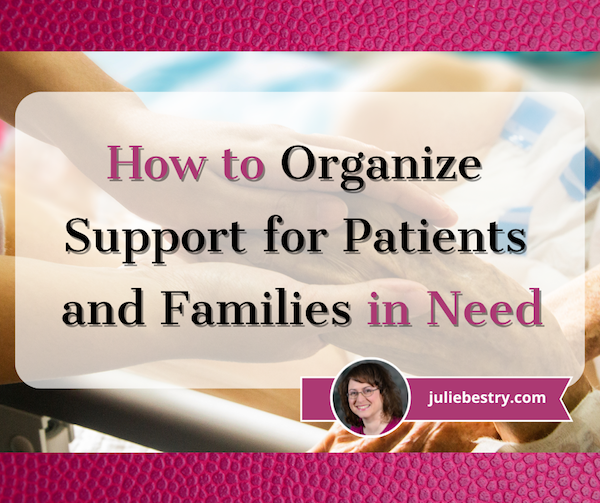
The following anecdote from inspirational teacher, speaker, and author John Perricone has been making the rounds on the web:
Several years ago, I invited a Buddhist monk to speak to my senior elective class, and quite interestingly, as he entered the room, he didn’t say a word. (That caught everyone’s attention). He just walked to the board and wrote this:
“EVERYONE WANTS TO SAVE THE WORLD, BUT NO ONE WANTS TO HELP MOM DO THE DISHES.”
We all laughed. But then he went on to say this to my students: “Statistically, it’s highly unlikely that any of you will ever have the opportunity to run into a burning orphanage and rescue an infant. But, in the smallest gesture of kindness — a warm smile, holding the door for the person behind you, shoveling the driveway of the elderly person next door — you have committed an act of immeasurable profundity, because to each of us, our life is our universe.”
This is my hope for you for the New Year, that by your smallest acts of kindness, you will save another’s world.
Recently, I’ve had small acts of kindness on my mind. Some friends, both near and far, have been going through difficult times, and it has had me thinking about what I can do for them, especially when I’m not close enough to help do the dishes.

Dishwashing Photo by Pavel Danilyuk
Most of the time, our goal in getting organized it to make our lives easier and prevent unfortunate things from happening. However, sometimes, through nobody’s fault, bad things happen. People get sick or injured, or family member die, or people just go through dark times, and no matter how organized they were (or we were on their behalf), life gets upended.
When that happens, when a family member or friend is in bad shape and everyone has to pull together to help take care of that individual or their family, organization is the key to making everything a little less chaotic.
In today’s post, we’re going to look at some strategies and resources for helping when someone you know is sick or injured or recovering, and they or their household could use a little support.
ASSESS THE SITUATION
We can’t presume to know what someone else needs, even if we’ve been in the same situation, or even if we’ve helped that same person before.
An organizing client recently told me that she and her husband had needed little assistance after the birth of their first child, but experienced profound difficulties after their second was born prematurely. She was in the hospital for an extended ime, and the baby was in the NICU for months after that.
After the first birth, she needed only a little errand-running and someone to sit with the baby so she could shower or nap. After the second, she and her husband felt exhausted and overwhelmed, and needed support for everything from meals and childcare to housekeeping and someone to check if they’d paid the bills.
Most people will welcome some assistance, while others struggle with the idea of letting well-intentioned others make arrangements. So, talk to them or their caregiver to get a sense of what kind of support they will need, want, and accept. Common categories of assistance might include:
- Grocery shopping — Depending on the individual’s or family’s preference, you may perform a weekly inventory and create a shopping list to share with others helping to cook, or you might help the family set-up and learn how to use online grocery shopping apps and arrange for delivery by someone in the support network.
- Cooking — Whether you’re helping with meal preparation in the home, or cooking at your house and delivering, ensure that everyone’s dietary preferences and restrictions are considered. It does nobody any good to have a freezer full of pasta-based casseroles if someone has a gluten sensitivity. (As much as everyone is environmentally conscious, this is one time when using disposable containers to lessen inconvenience should be considered.)
- Cleaning — When you don’t feel well, messy or dirty surroundings will make everything worse. Imagine the relief of a clean bathroom and a tidy kitchen for someone spending most of their time at home or in medical settings.
- Childcare and transportation to/from school and extracurriculars — This might be a good fit for friends who are parents of the children’s classmates, but don’t forget to invite “aunties” and “uncles,” relatives or not. When things are stressful at home, whether there’s an illness or a new baby, getting a special day out with grownup who isn’t a parent or grandparent can make a child feel valued and like a VIP.
- Errand-running — Having someone who can dependably pick up prescriptions or make store returns ensures that the household can still run (somewhat) smoothly without daily stressors.
- Pet care — Fido and Fluffy may not be able to talk about their feelings, but you know they sense that something is going on. Some people in the support network might limit their efforts to feeding and cleaning up after pets, while others might be up for taking pets on an adventure to the dog park or the groomer.

Toddler Walking Dog by Robert Eklund on Unsplash
- Transportation to medical appointments — Imagine how uplifting it would be have a trusted friend take you to your appointments and feel, even for a little while, like the company you’re keeping with them is just a normal excursion!
- Serving as a scribe during medical appointments — Being ill is stressful, and it’s hard to focus when you’re not feeling physically and/or mentally at your best. Having a trusted, confidential friend available to take notes, and maybe even to ask questions if you see they’re looking confused, could be a huge comfort. (It’s a plus if the person has any medical background, like a retired nurse or PA, but in a pinch, you’d be surprised how much someone picks up watching two decades of Grey’s Anatomy.)
- Acting as entertaining/distracting company during chemo or other treatments, and during convalescence. Again, whatever someone can do to make a moment or an hour feel “normal” might be a blessing.
- Emotional support, both for the person and their caregiver(s) — This is an especially good category for loved ones who live at a distance. Having someone in the Pacific Time Zone who’s awake and able to offer a shoulder when everyone in your time zone is asleep gives patients (and their families) the chance get what they need without feeling burdensome. Encourage people who can’t participate in more formal support schedules or visit in person to be there however they can, even if that’s a card or a texted meme.
Read about others way to help.
How to Help Someone Who is Sick (An impressive list from the Kansas Health System)
How Not to Help a Friend in Need (New York Times)
50 Thoughtful Gift Ideas & Gestures for a Friend in Need (PrettyWellness.com)
Do not just ask, “What can I do?”
This puts the onus on someone whose mental reserves are already taxed to try to conceptualize what they need and try to feel comfortable asking for a favor. Instead, your goal is to to say, “Here are the things we’ve thought of. What are you comfortable letting us do? Is there anything we’ve forgotten that we could add to the list?”
CREATE A SUPPORT NETWORK
Even if you’re the sibling, the in-law, or the best friend, you can’t do it alone. If someone you love is going through any kind of illness, treatment, or recovery, or is otherwise in a difficult position (for example, is in grief or suffering depression), you can’t be the magic wand that solves all the problems. What you can be is a project manager so that, together, you can all maneuver that wand to make a little comforting magic.
Gather your community.
With the permission of your loved one and/or their partner or caregiver, reach out to friends, family members, neighbors, and colleagues to see who is willing and able to help. Use social media, email, texts, or phone calls to inform people what you’re trying to do and why, and ask for their support.
Make clear that you’d much rather someone take on a smaller role and be able to contribute than to take on too much and not be able to provide what’s promised when the time comes.
Don’t presume that everyone is equally skilled and comfortable with all tasks. Provide a list of the tasksto be completed, and ask individuals to state where and when they’re able to help. People who love to cook will find it easy to “make double” when preparing meals, while those with flexible schedules and a love of kids will probably be eager to play taxi from school to ballet or soccer and then home.
Coordinate a schedule.
Once you have a group of people who are ready to help, you’ll want to establish a schedule that ensures the person you’re supporting receives consistent help without overwhelming any one individual.
This may involve setting up rotating shifts for different categories of tasks or assigning specific days to different people. Some in the network will have a great deal of flexibility while others can only help on weekends or evenings. Meet people where they are.
Communicate clearly.
Once everyone is on-board with providing support, select a method to ensure clear and open communication.
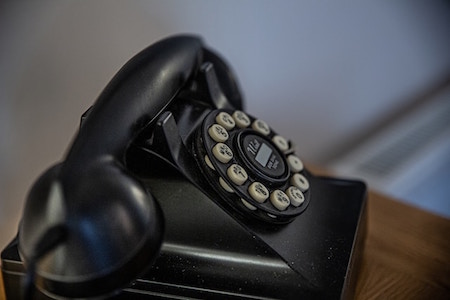
Rotary Phone by Sam Loyd on Unsplash
Different people (and definitely different generations) have decidedly varying communications preferences. Boomers and retirees might not mind phone calls, while GenZ and Millennials (and folks with jobs that require a lot of intense focus) are more likely to prefer texting or emails, so they can reply at their convenience. Create a master list with everyone’s name, phone number, email number, and preferred contact method, and if everyone is amenable, share it as a spreadsheet in Google Drive or a note in Evernote.
Sometimes, you’ll want to communicate with the entire group rather than individuals, and email might work best. There are also online platforms (as we’ll discuss below) to help develop support calendars, allowing individuals to sign up for the tasks and times that work best for them.
Communicate with the person/family, too. If people are going to be showing up to drop off food, make sure they know the schedule, and get the OK for how things get delivered or accomplished. They may prefer that nobody come to the house before 10 a.m., or that meal deliveries come to the side/back door (which may be easier for a recovering person to access), or that they get a text ten minutes in advance of anyone showing up.
Remember the importance of privacy and confidentiality.
I can tell you from first-hand experience that being a patient, whether for an acute condition or a chronic one, means having to give up far too much privacy and dignity. Remind and encourage everyone involved to respect the individual’s confidentiality. Someone may feel great about having delivered three days of meals to the family and want to share that warm fuzzy on social media, but nobody’s humblebrag should come at the expense of another person’s privacy.
Of course, it should go without saying that only the individual you’re supporting (or, if applicable, the family) should be sharing medical updates (unless a proxy is asked to do so).
Consider crowdsourcing professional support.
Depending on the individual’s needs, the support community may want to provide funds to help accomplish professional work when the individual in crisis is unable to perform their usual tasks. Help might include a professional organizer for household functionality, a daily money manager to keep up with finances, or an academic tutor for the children.
Your network might want to gift the individual in-home massages or salon services (manicures, hair/scalp care, skin care, etc.) to boost their spirits and support their physical well-being.
Embrace flexibility.
As you likely know, health conditions can be unpredictable and do not abide by the calendar. Be prepared to adapt and reconfigure the support schedules as needs change.
USE SUPPORT RESOURCES THAT ALREADY EXIST
There’s no need to reinvent the wheel. Take advantage of resources that can complement the efforts you’re already making.
Meal and Support Scheduling Platforms

Caring Bridge — One of the best-known platforms of its kind, Caring Bridge exists to help provide updates during a health crisis. It’s like a cross between a personalized web site and social media in that family or assigned parties can create posts updating someone’s health status and needs, and others can provide supportive comments. However, Caring Bridge also has a planner that allows volunteers to offer help with all the categories described above.
Caring Bridge is free to use, has no advertising, and is a non-profit.

Meal Train — This calendar platform lets family, friends, neighbors, and colleagues sign up to provide meals for the person/family in need. It takes a lot of the administrative weight off of whomever is project-managing the family’s support, and Meal Train provides a straightforward way to organize and coordinate meal deliveries to ensure that the patient is getting nourishment and that the household isn’t eating takeout pizza for weeks on end.
- Create a free Meal Train page for the person/family whom you’re supporting.
- Enter the dates when meals will be needed.
- Fill in all of the preferences including favorite foods, food allergies/sensitivities, and the ideal drop-off times to avoid disturbing the patient or family.
- Share the Meal Train link with everyone in the support network so they can sign up to provide meals.

Members of the support network might benefit from reading some of Meal Train’s helpful articles, like:
11 Trips: Meal Train Etiquette for the Savvy Participant
6 Tips for Delivering your Meal
When Dropping Off a Meal, Should I Stay or Should I Go?
Although Meal Train is free, there’s a Pro level for $15/month for groups that might need to oversee multiple support pages. For example, if your house of worship or community group makes a point of supporting families in need, Meal Train Pro is an option.

Lotsa Helping Hands — is similar to Caring Bridge and Meal Train in that it supports the creation of a caregiving community. You can organize and coordinate all of the cooking, cleaning, errand-running and other tasks described earlier in this post, and individuals can sign up to provide support based on the person’s/family’s specific needs and each individual’s capacity.
The platform includes a care calendar for volunteers to sign up for tasks, an announcement page for updating everyone on progress or setbacks, a “well wishes” pages for sending messages to the patient and family, and a photo gallery for sharing supportive pictures.
Specialized Platforms
Not everyone makes an ideal volunteer for providing meals. But just because you (by which I mean I) can’t cook doesn’t mean you can’t provide a meal. Sure, you can use a service like Door Dash or GrubHub to dial up a person’s favorite restaurant meal and have it delivered, but sometimes you want a person to have a real home-cooked meal, even if you know they’re better off not having it cooked in your home.
To that end, I was delighted to discover Lasagna Love.

Lasagna Love provides delicious lasagnas for those in need. It might be for a patient, a family who has had a new baby, or even for someone you know who is just going through a really rough patch. Lasagna Love is a bit of a community, itself. You can:
- Request a lasagna for yourself or someone in need — Search by zip code to see if Lasagna Love is operational near you. You’ll get matched to a local lasagna chef to coordinate a date and time, and then you’ll get a safe and contactless delivery of lasagna!
- Volunteer to make lasagnas for people who have requested them.
- Donate to the cause!
- Sponsor a lasagna chef through Patreon.
The site describes its efforts this way (emphasis mine):
Lasagna Love is a global nonprofit and grassroots movement that aims to positively impact communities by connecting neighbors with neighbors through homemade meal delivery. We also seek to eliminate stigmas associated with asking for help when it is needed most. Our mission is simple: feed families, spread kindness, and strengthen communities.
Something tells me that the Buddhist monk in John Perricone’s classroom would approve. After all, if you’re making the lasagna for someone who needs it, it’s goes one step beyond helping Mom do the dishes. It’s may be a small act of kindness, but one with huge potential results.
If you think you’d like to become a lasagna chef, learn how to get involved at the website and take a peek at the simple graphic, below.
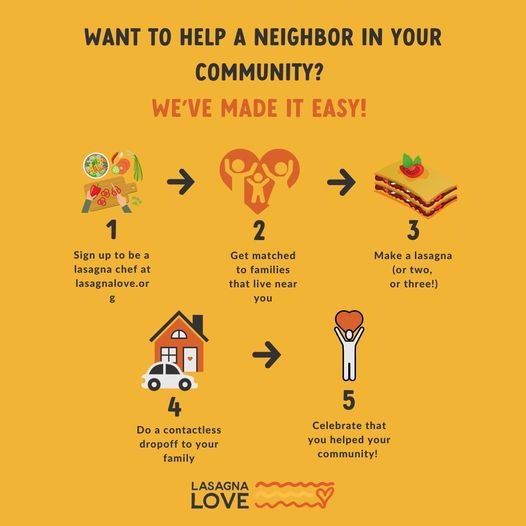
Make lasagna once or become an ongoing lasagna chef or find a balance somewhere in between. Hear more directly from Rhiannon Menn, the founder:
While Lasagna Love was a brand new concept to me, the next resource is the one I’ve known about the longest, and have been gratified to recommend it to clients and others who have sought referrals.

Cleaning for a Reason — This 501(c)(3) nonprofit organization provides free home cleaning to patients battling cancer.
Cleaning for a Reason connects its trusted network of 1200 residential cleaning companies, cleaning industry volunteers, and community volunteers with cancer patients and their families to provide a clean, healthy environment.
Patients or their loved ones can apply for two free home-cleaning sessions and use this page to find a service provider. Cleaning for a Reason serves all individuals and families with any type of cancer, and patients are eligible if they’re recovering from cancer surgery, in cancer treatment, or in hospice care.
Cleaning for a Reason allows applications to be submitted by family, friends, and colleagues, as well as caregivers, doctors, and nurse navigators, but asks that you first verify that the patient is willing to accept the services.
Hear more from the founder, Debbie Sardone:
You can read about the program at the Cleaning for a Reason site and on the Facebook page.
If someone you care about is ill or going through a difficult time, anything you do to let them know they are loved and valued will help. However, if you’re able to project-manage or volunteer by providing organized and consistent support, it will make a significant difference in their well-being during challenging times.
Whether you do the dishes, make a lasagna, organize the troops, or come armed with two boxes of tissues, it’s worth repeating: “By your smallest acts of kindness, you will save another’s world.”
Paper Doll and Friends Cross an Ocean for Fine Productivity Conversations

When you love what you do, it’s easy to make connections with people involved in the same things. This is especially true for me when I get around people who like to talk about organizing and productivity. (I mean, who wouldn’t want to talk about productivity and organizing?)
DO YOU HAVE AN ORGANIZED PERSONALITY?

At the start of May, I saw that my friend, accountability partner, and friend-of-the-blog Dr. Melissa Gratias had posted that she was a guest on Jon Tromans’ Triple “T” Productivity Podcast in an episode called Productivity. It’s all in your mind! A chat with Dr Melissa Gratias. Jon’s in the UK, Melissa’s in Savannah, and the conversation was out of this world!
(You know Melissa from many posts, but especially Paper Doll Interviews Melissa Gratias, Author of Seraphina Does Everything!)

Melissa and Jon pondered the age-old question of whether we are born productive (or unproductive), or whether it’s matter of environment and training. As Melissa is a trained in psychology (she has a Ph.D. in Industrial and Organizational Psychology!) she offered insight based on “the Big Five personality traits” in the Five-Factor Model of Personality (also called The Big Five Model), and particularly the role of conscientiousness. I found this fascinating and jumped in to read more!
For those who haven’t taken a Psych class since college, the theory (which can go by the acronym CANOE or OCEAN) says that personality can generally be examined in terms of five core factors, each along a continuum:
- Conscientiousness — You might think that being conscientious is just a good policy. However, as a character trait, one can over- (or under-) do it. Too high on the conscientiousness continuum, and you might be a perfectionist or workaholic; too low and you might give in to impulsiveness, irresponsibility, and disorganization. The goal is to be organized, responsible, and productive without going overboard into the toxic productivity realm we’ve been talking about lately here on the blog. Melissa talked with Jon about the correlation of the conscientiousness personality trait in seeming to be “naturally” organized.
- Agreeableness — Understandably, the continuum here ranges from those who are too trusting, selfless, and possibly even gullible on the high end to being overly suspicious, uncooperative (or — eek! — manipulative) on the low end. Someone striking a balance will be compassionate, respectful, and trustful to a logical degree.
- Neuroticism — Note that this refers to the tendency to experience negative feelings. Neuroticism feels like the one odd duck in the model, because one would assume you wouldn’t want to be neurotic at all! As you’d expect, at the high end of neuroticism, someone might be anxious or depressed, pessimistic, and even filled with shame. But on the low end, it’s apparently possible to have too little neuroticism, leading to a sense of shamelessness. The safe harbor here is being confident and calm,
- Openness to Experience — Those toward the high end may be seen as imaginative or creative, spontaneous, and curious, while those in the comfortable middle may be prefer practicality and routine, and at the low end might seem inflexible.
- Extraversion — The range of extraversion is wide, and someone might range from attention-seeking to reserved. Basically, you want to be out there but not too out there! (Someone should have discussed this with 7-year-old Paper Doll.)
If you’d like to read more about this model, these articles offer a good start:
Big 5 Personality Traits (Psychology Today)
Big Five Personality Traits: The 5-Factor Model Of Personality (Simply Psychology)
What Are the Big 5 Personality Traits? (Psych Central)
For what it’s worth, I did a self-test at BigFive-Test.com (having searched for a free test, I picked one at random) and got the following results. As you can see, I score highest on conscientiousness, which would seem to validate Melissa’s wise thoughts on Jon’s podcast, given my field of work.
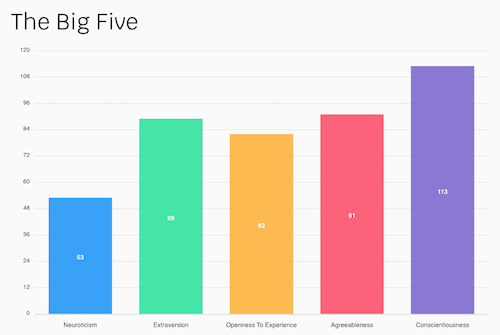
The results also looked at various characteristics within each trait. For example, extraversion looked at friendliness, gregariousness, assertiveness, activity level, excitement-seeking, and cheerfulness. Conscientiousness broke down the score for self-efficacy, orderliness, dutifulness, achievement-striving, self-discipline, and cautiousness.
And speaking of caution, this was just a free internet test, probably more valid than Which Grey’s Anatomy Character Are You? but not as valid as working with a psychologist or expert in this kind of testing. Also, in case you’re wondering, at least according to the internet, I’m Lexie Grey.
Lexie Grey via GIPHY
(Even considering the dangers of the Red Wedding, something tells me I should have gone with a Game of Thrones character quiz!)
But I digress. We were talking about Jon Troman’s Triple “T” Productivity Podcast.
JON TROMANS’ CAST OF CHARACTERS
I was charmed by Jon’s interview with Melissa, which mixed fun and lively conversation with a deep dive into philosophies of productivity. Although I did not know Jon, I recognized his name as a fellow Evernote Certified Expert, and made a point to learn more about him.
The next week, he profiled a professional organizer, Lucy Milligan Wahl, owner of LMW Edits in San Francisco for the episode Maximizing Productivity through an Organised Life. A chat with Lucy Milligan Wahl.

Lucy is a NAPO colleague, and while she and Jon did discuss Evernote and organizing, I was most taken by her approach to making a symbolic (and clear) division between life and work through ritual. It was a compelling chat, and I felt like I was listening in on a cool conversation at the next table in a café.
By the next episode, Me And My Evernote With Ray Sidney-Smith, I was definitely hooked. Ray being on the podcast was a double-delight for me. First, you’ve already met my productivity buddy Ray in many Paper Doll posts, so you’ve read how much I respect him, like in Paper Doll Picks: Organizing and Productivity Podcasts. He is one of the kindest individuals I’ve ever met, with a wicked/quick/clever sense of humor, and a wisdom surrounding productivity concepts in general and Evernote and David Allen’s Getting Things Done in particular.

But Ray is also special to me because he was my very first Evernote friend. We were in the same certification class, way back in 2015, and I am always agog at how much he manages to do, because is he reminds me of that movie title, Everything Everywhere All at Once.
He works a day job, he knows everything there is to know about Evernote, he leads in-person and virtual productivity meet-ups, and as he disclosed in the episode, he’s read more than 400 productivity books! According to my Goodreads book list, I’ve read a lot, but 400?!
For what it’s worth, I messaged Ray to see if he’s got a written, sharable list of his books, but sadly no. To be honest, I’m a bit shocked he doesn’t have an Evernote note listing every title, but he’s taken my request on board and put it on his Maybe/Sometime task pile. I’ll be sure to let readers know if he comes forward with a full accounting of all of the titles!)
MEETING THE MAN HIMSELF
At this point, having listened to three of my friends and colleagues get to chat with Jon (and then going back to hear his convo with our fellow Evernote Certified Expert Vlad Campos, maker of fascinating technology, productivity, and Evernote videos), I had to let Jon know how much I appreciated his stuff.

I did a little poking around and found that, like me, he had a whole prior career in broadcasting! (You can be sure that, off-microphone, had and I have now had some rollicking conversation about that era of our lives.) He also builds websites, develop marketing campaigns, and works with businesses to improve their digital content. Plus, he hosts the Not Another Marketing Podcast that covers the whole realm of digital marketing.
On top of it all, which is what made me realize he was more than just the guy I knew from the Experts forum, he started the Taming the Trunk newsletter and community. (The “trunk,” for the uninitiated, is the Evernote elephant logo’s trunk.) And from there, I guess creating the Triple “T” (get it? “Taming the Trunk?) Productivity Podcast was a natural extension.

Jon’s located on the Welsh border in Shropshire, West Midlands, and while I did get to go to England, Wales, and Scotland on my 2019 tour of the UK, I never got that close to where he is, which is a real shame because (as you’ll hear if you listen to any of these podcast episodes) he and his charming accent are a delight!
Once we realized all the connections between us, Jon was lovely enough to invite me on his show, and we recorded the episode, Me and my Evernote with Julie Bestry, last week. I think you’ll be able to tell that we had a ball!
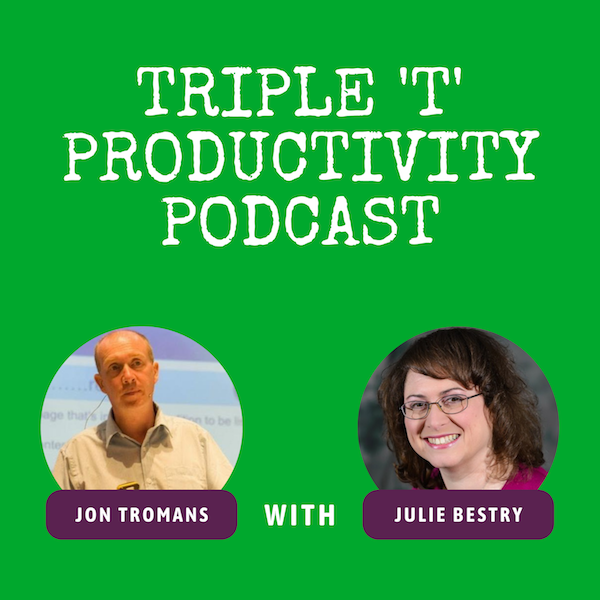
Jon asked me about all my favorite topics, from my take on paper vs. digital to what I really think of the idea of scanning all of your papers. Plus, Jon’s got a short list of questions he asks all of his guests, including a knockout of a question about life advice, which gave me a chance to share the always-brilliant wisdom of Paper Mommy.

You can listen to all of these episodes at the website episode pages to which I’ve linked above or at the episode archive, but for the full experience, subscribe and listen to the Triple “T” Productivity Podcast at Apple Podcasts, Spotify, Amazon, and (as they say) wherever you get your podcasts.
I invite you to listen to my episode and let me know what you think.





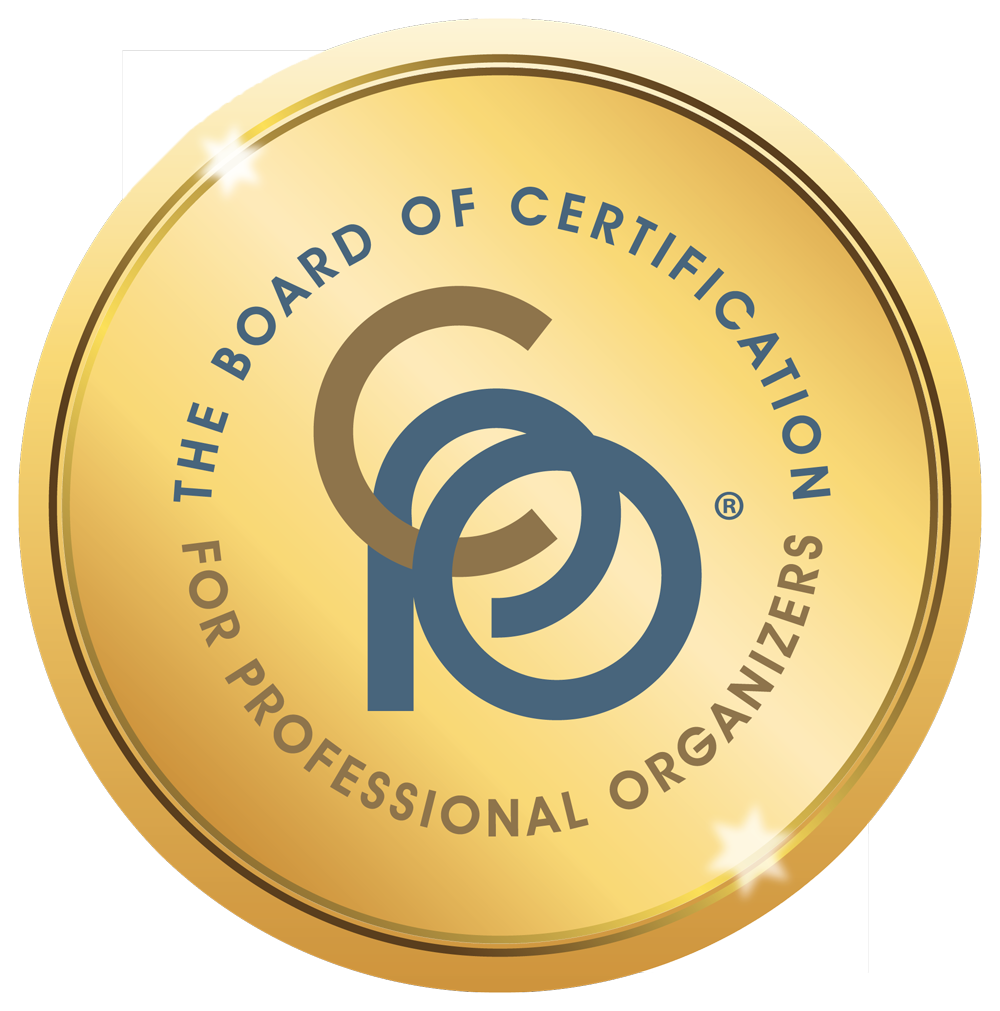
Follow Me